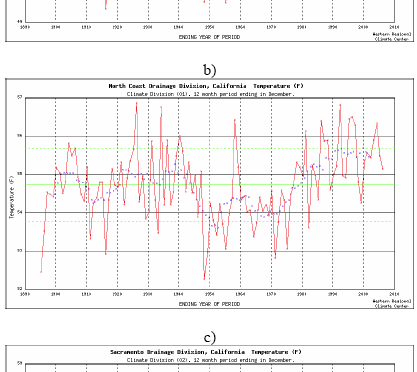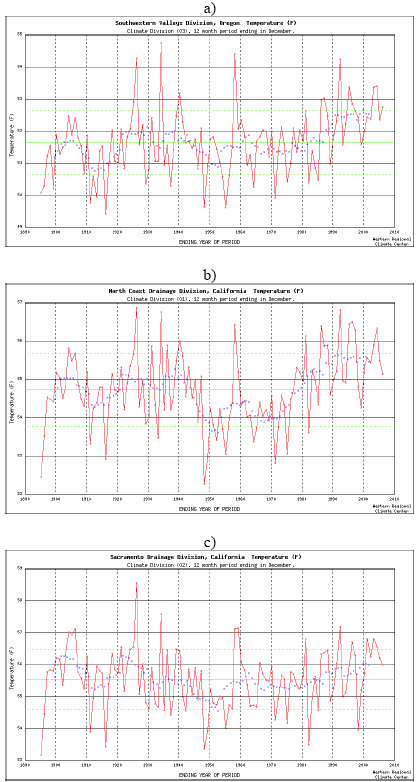Weather and Climate Inventory, Klamath Network, National Park Service, 2007
2.0. Climate Background
2.3. Temporal Variability
The Pacific-North America Oscillation (PNA; Wallace and Gutzler 1981) is an important contributor to variability of storm frequencies and tracks during a given year, with variations on the order of weeks. Negative phases of the PNA generally bring cooler temperatures and increased storminess over the KLMN, especially to the park units in Oregon.
Both the El Niño-Southern Oscillation (ENSO) and the Pacific Decadal Oscillation (PDO) cause interannual climate variations in the KLMN (Redmond and Koch 1991; Mock 1996; Cayan et al. 1998; Mantua 2000; Mantua and Hare 2002). El Niño conditions and/or positive phases of the PDO are associated with warmer and drier than normal conditions, particularly in northern KLMN, while La Niña conditions and/or negative phases of the PDO are associated with cooler and wetter than normal conditions.
An investigation of daily precipitation amounts around the KLMN region over the last century (Figure 2.7) reveals little in the way of an overall trend, although portions of southwestern Oregon may be showing some precipitation increases during this time period (Figure 2.7a). Throughout the KLMN, a drier period is apparent during the first part of the twentieth century. This shows up particularly well in southwestern Oregon, but is also apparent in northern California (Figures 2.7b,c).
Long-term trends in ambient temperature (Figure 2.8) indicate that temperatures have become slightly warmer over the past century, particularly in northern portions of the KLMN (Figures 2.8a,b). This finding is in line with other studies of temperature trends over the western U.S. (NAST 2001). However, it is not clear how much of this observed pattern may be due to discontinuities in temperature records at individual stations, caused by artificial changes such as station moves. These patterns highlight the emphasis on measurement consistency that is needed in order to properly detect long-term climatic changes.
Figure 2.7. Precipitation time series, 1895-2005, for selected regions in the KLMN. These include twelvemonth precipitation (ending in December) (red), 10-year running mean (blue), mean (green), and plus/minus one standard deviation (green dotted). Locations include southwestern Oregon (a), the northern California Coast (b), and the upper Sacramento River basin (c).
Figure 2.8. Temperature time series, 1895-2005, for selected regions in the KLMN. These include twelvemonth average temperature (ending in December) (red), 10-year running mean (blue), mean (green), and plus/minus one standard deviation (green dotted). Locations include southwestern Oregon (a), the northern California Coast (b), and the upper Sacramento River basin (c).
Other pages in this section
- 01 Weather and Climate Cover
- Final 2001 Air Emissions Inventory, Crater Lake National Park, Oregon, PDF, October 2003
- 02 Acronyms
- Final Report: Status of Air Quality and Effects of Atmospheric Pollutants on Ecosystems in the Pacific Northwest PDF 1994
- 03 Executive Summary
- Crater Lake National Park Air Quality Information Overview
- 04 Acknowledgements
- 05 1.0. Introduction
- 06 1.1. Network Terminology
- 07 1.2. Weather versus Climate Definitions
- 08 1.3. Purpose of Measurements
- 09 1.4. Design of Climate-Monitoring Programs
- 10 2.0. Climate Background
- 11 2.1. Climate and the KLMN Environment
- 12 2.2. Spatial Variability
- 14 2.4. Parameter Regression on Independent Slopes Model (PRISM)
- 15 3.0. Methods
- 16 3.1. Metadata Retrieval
- 17 3.2. Criteria for Locating Stations
- 18 4.0. Station Inventory
- 19 4.1. Climate and Weather Networks
- 20 4.2. Station Locations
- 21 5.0. Conclusions and Recommendations
- 22 5.1. Klamath Inventory and Monitoring Network
- 23 5.2. Spatial Variations in Mean Climate
- 24 5.3. Climate Change Detection
- 25 5.4. Aesthetics
- 26 5.5. Information Access
- 27 5.6. Summarized Conclusions and Recommendations
- 28 6.0 Literature Cited
- 29 Appendix A. Glossary
- 30 Appendix B. Climate-monitoring principles
- 31 Appendix C. Factors in operating a weather/climate network
- 32 Appendix D. General design considerations for weather/climate-monitoring programs
- 33 Appendix E. Master metadata field list
- 34 Appendix F. Electronic supplements
- 35 Appendix G. Descriptions of weather/climate monitoring networks




